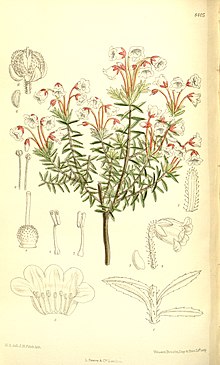Moss heaths
| Moss heaths | ||||||||||
|---|---|---|---|---|---|---|---|---|---|---|

|
||||||||||
| Systematics | ||||||||||
|
||||||||||
| Scientific name | ||||||||||
| Phyllodoce | ||||||||||
| Salisb. |
The Moosheiden ( Phyllodoce ) are a genus of plants within the family of the heather plants (Ericaceae). The seven to eight species are circumpolar in the northern hemisphere in the boreal zone in North America and Eurasia.
description


Vegetative characteristics
Phyllodoce species grow as small, evergreen shrubs . They often grow out of rhizomes , with the base of the shoot being surrounded by clumps of old petioles. They have upright or spreading stems. The bark of young twigs is shiny hairy and the older, strong and disheveled branches are bare.
The leaves are alternate or opposite. The narrow, leathery leaf blades are linear and curled up near the finely serrated edges.
Generative characteristics
The terminal, umbel-shaped inflorescences contain only one flower or up to 30 flowers and bracts .
The hermaphroditic flowers are radial symmetry and five-fold with a double flower envelope . The five durable sepals have grown together to form a relatively small calyx. The five petals are fused at least up to half of their length to form a jug-shaped or bell-shaped corolla that ends in five corolla teeth. There are two circles with usually five, rarely four or six stamens , which usually do not protrude above the corolla. The anthers open with pores. The stylus is slim.
The spherical, five-fold capsule fruits open loculicidally and contain more than 100 tiny seeds. The seeds are egg-shaped.
Systematics and distribution
The genus Phyllodoce was established in 1806 by Richard Anthony Salisbury in The Paradisus Londinensis , 1, plate 36. Type species is Phyllodoce taxifolia Salisb. nom. illegal. superfl., it is a synonym of Phyllodoce caerulea . The genus name Phyllodoce refers to one of the Nereids in Greek mythology .
The genus Phyllodoce belongs to the tribe Phyllodoceae in the subfamily Ericoideae within the family Ericaceae .
The Phyllodoce species thrive in arctic - alpine areas.
Even after phylogenetic analyzes , the relationships between the individual species are unclear.
There are seven to eight species within the genus Phyllodoce :
- Phyllodoce aleutica (Spreng.) A. Heller : It occurs from Alaska to East Asia .
- Phyllodoce breweri (A.Gray) A.Heller : It thrives on subalpine meadows and on rocky slopes in the Cascade Mountains, in the Sierra Nevada and in the San Bernadino Mountains at altitudes of 1200 to 3500 meters in the western US states of Nevada and California .
- Phyllodoce caerulea (L.) Bab. (Syn .: Phyllodoce taxifolia Salisb. ): It is common in Eurasia and North America.
- Phyllodoce deflexa Ching ex HPYang : in forests at altitudes of about 1700 meters only in Jilin .
- Phyllodoce empetriformis (Sm.) D.Don : It occurs from subarctic to western North America. There are localities for the Canadian territory of the Yukon and the Canadian provinces of Alberta and British Columbia and the US states of Alaska Idaho , Montana , Oregon , Washington and California. It thrives on moist subalpine to alpine slopes at altitudes of 1400 to 3500 meters.
- Phyllodoce glanduliflora (Hook.) Coville It occurs from subarctic to western North America. There are localities for the Canadian areas of the Northwest Territories as well as Yukon and the Canadian provinces of Alberta and British Columbia and the US states of Alaska, Montana, Oregon, Washington and Wyoming .
- Phyllodoce nipponica Makino (Syn .: Phyllodoce amabilis Stapf , Phyllodoce empetriformis . Var amabilis (Stapf) Rehd. , Phyllodoce nipponica var. Amabilis (Stapf) Stoker ): It is used in Japan before.
There are nature hybrids .
Individual evidence
- ↑ a b c d e f g h i j k l m n Yang Hanbi (杨汉 碧 Yang Han-pi), David F. Chamberlain: Phyllodoce. Pp. 258-259. In: Wu Zheng-yi, Peter H. Raven, Deyuan Hong (Eds.): Flora of China. Volume 14: Apiaceae through Ericaceae. Science Press and Missouri Botanical Garden Press, Beijing and St. Louis. 2005, ISBN 1-930723-41-5 : - online with the same text as the printed work.
- ↑ a b c d e f g h i j k l m n John G. Packer, A. Joyce Gould: Phyllodoce. Pp. 476-478. In: Flora of North America Editorial Committee (Ed.): Flora of North America North of Mexico. Volume 8: Magnoliophyta: Paeoniaceae to Ericaceae. Oxford University Press, New York and Oxford, 2009, ISBN 978-0-19-534026-6 : - online with the same text as the printed work.
- ↑ a b c d e f Gary D. Wallace: Phyllodoce. Jepson Flora Project. In: The Jepson eFlora. Jepson Herbarium, UC Berkeley, 2012, accessed August 16, 2019 .
- ↑ a b c d e f Phyllodoce in the Germplasm Resources Information Network (GRIN), USDA , ARS , National Genetic Resources Program. National Germplasm Resources Laboratory, Beltsville, Maryland. Retrieved August 16, 2019.
- ^ Phyllodoce at Tropicos.org. Missouri Botanical Garden, St. Louis, accessed August 16, 2019.
- ^ RM Rochefort, DL Peterson: Genetic and morphologic variation in Phyllodoce empetriformis and Phyllodoce glanduliflora (Ericaceae) in Mount Rainier National Park, Washington . In: Canadian Journal of Botany . tape 79 , no. 2 , 2001, p. 179–191 (English, usgs.gov [PDF]).
- ↑ H. Ikeda, V. Yakubov, V. Barkalov, H. Setoguchi: Molecular evidence for ancient relicts of arctic-alpine plants in East Asia . In: New Phytologist . 203 number = 3, 2014, p. 980-988 , doi : 10.1111 / nph.12863 (English, wiley.com ).
Web links
- Vascular Plants of the Americas : Phyllodoce at Tropicos.org. In: 83 . Missouri Botanical Garden, St. Louis
- Phyllodoce . In:USDA PLANTS. United States Department of Agriculture. Retrieved August 13, 2019.